
Where Stockholm Learned to Listen Again
By Rafi Mercer
New Listing
Hosoi is one of Stockholm’s most finely tuned listening bars — explore more in our Sweden Music Venues guide.
Venue Name: Hosoi
Address: Styckmästargatan 5, 121 62 Johanneshov, Stockholm, Sweden
Website: hosoistockholm.com
Instagram: @hosoisthlm
Facebook: Hosoisthlm
The first time you walk into Hosoi, there is an instinct to whisper. Not out of intimidation, but because the air itself seems tuned, as if someone has adjusted the room’s frequency before you arrived. Outside, Slakthusområdet — the old meatpacking district south of central Stockholm — still carries the industrial breath of decades past. Concrete façades, a rhythm of shuttered warehouses, neon signs that remember another era. Inside Hosoi, the energy shifts. You step into a long, pared-back interior, and the first thing that greets you is not a bartender, nor a plate, but the presence of sound itself. It doesn’t demand attention; it simply occupies the air in a way that insists on being noticed.
Hosoi’s philosophy is embedded in its name. The word, borrowed from Japanese, translates to “narrow” or “slender” — but here it suggests something finer: a narrowing of focus, a stripping away until what remains is essential. This is not a place where music is background. It is the foreground, the architecture, the mood board, the very reason you’re here.
To understand Hosoi is to trace its story. It began as a discreet listening room within the Hotel At Six in central Stockholm. Launched in 2017, it brought something unexpected to the city: a Scandinavian interpretation of the Japanese kissaten — those intimate cafés where jazz records spun on heavy turntables for audiences who came to listen, not chatter. Hosoi at At Six was a hidden space, almost a secret, a word passed between the curious and the devoted. It was acoustically treated, aesthetically minimal, and it quickly attracted a following among Stockholmers who wanted to experience music with the seriousness of theatre.
Then the pandemic came, and like so many cultural spaces, Hosoi dimmed its lights. But unlike some, it wasn’t a final curtain. The project re-emerged with a new address and a new ambition. Hosoi reopened in Slakthusområdet, a district in transition, where derelict meat halls are being reimagined as cultural stages, design showrooms, and clubs. The relocation gave Hosoi space to expand its identity: not only a listening lounge but also a restaurant and bar, a social house for food, drink, and dance — always with music as the axis.
Walk in today and you’ll see that expansion in motion. The room is uncluttered, industrial bones softened by warm lighting and wood accents. Scandinavian restraint meets Japanese minimalism. There’s an honesty to the design, the sense that nothing is superfluous. The focus is the sound system. Hosoi’s setup — built in consultation with audiophile engineers — leans on McIntosh amplification, a set of high-fidelity loudspeakers carefully aligned to the room, and turntables balanced to track vinyl with precision. The system is not ornamental. It is the heart of the room.
The experience of listening at Hosoi is not about volume but about presence. The bass doesn’t thud; it resonates. High notes don’t pierce; they glisten. The geometry of sound here feels architectural: low frequencies move like foundations, mids carry the structure, highs lace across the ceiling like glass. You don’t just hear a record; you feel how it is housed.
Programming is another layer of its character. Hosoi curates selectors and artists with an ear for narrative — DJs who understand that an evening can unfold like an essay. The genres are broad, but the intent is consistent: this is music chosen to be listened to, to be lived inside. It isn’t unusual for Hosoi to host a guest who plays deep jazz on a Friday and another who arcs from ambient electronics to dub on a Saturday. What binds them is the attention to sonic texture, to dynamics, to journey.
But Hosoi is not purist in the way of some Japanese kissaten, where silence is enforced and conversation discouraged. Here, the philosophy is more fluid. You are welcome to speak, to drink, to eat — but you are also reminded, subtly, that the sound is not secondary. There’s a respect for the music that filters into the behaviour of the room. Voices lower. Phones stay in pockets. People lean into the sound instead of away from it.
The food and drink offering extends the ethos. Plates are designed for sharing, flavours clean and balanced. Cocktails arrive in glassware that feels weighted, deliberate, never showy. Even here, you sense the listening. Just as a glass can alter the way you savour whisky — slowing you down, grounding you — the dishes and drinks at Hosoi are composed to complement the sound. Eating becomes part of the rhythm of the evening, not a distraction from it.
The location in Slakthusområdet is not incidental. The district is on the cusp of reinvention, shifting from utilitarian past to cultural future. Hosoi positions itself at the forefront of that evolution, a signal of what is possible when old shells are reimagined as vessels for new kinds of community. In that sense, Hosoi is both local and global: rooted in Stockholm’s changing cityscape, yet connected to the wider lineage of listening culture that began in post-war Japan and has spread to New York, London, Paris, and beyond.
There’s also a festival arm: Hosoi has curated its own multi-day events, bringing together selectors, live acts, and audiences in a format that extends the bar’s philosophy into the open air. These are not mass spectacles but gatherings, carefully scaled, where the fidelity of experience is protected. In a world where festivals often chase volume and spectacle, Hosoi’s approach is refreshing: intimacy over enormity, depth over breadth.
What makes Hosoi essential is that it doesn’t treat listening as nostalgia. This is not an exercise in fetishising vinyl, or in clinging to some imagined golden age of jazz cafés. It is contemporary, alive, in dialogue with its surroundings. You could walk in on a Wednesday and hear a selector mixing minimal house with rare groove. You could come back Friday and hear a full evening of Coltrane on pristine vinyl. Both belong, because both are curated with intent.
Listening here is an act of care — from the staff who position themselves as stewards of the experience, to the selectors who carry crates with purpose, to the patrons who understand, sometimes unconsciously, that this is a room where sound has dignity. That is perhaps Hosoi’s greatest success: it doesn’t lecture or enforce. It simply demonstrates, by design, by programming, by atmosphere, that music can be central. And in doing so, it reminds people how to listen again.
When you leave, the outside feels louder. The street, the traffic, the shuffle of feet on concrete — all of it seems suddenly amplified. That is the mark of a true listening space: it recalibrates you. Hosoi is not just another bar. It is an acoustic reset button in the middle of Stockholm, a place where you measure the night not by drinks consumed but by records remembered.
Rafi Mercer writes about the spaces where music matters. For more stories from Tracks & Tales, subscribe here, or click here to read more.






